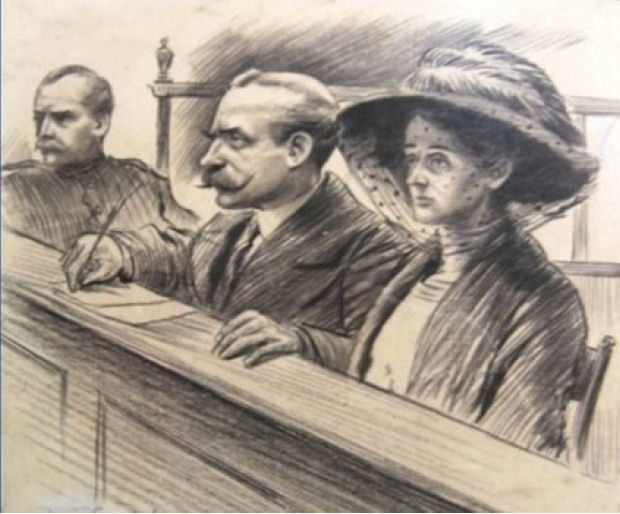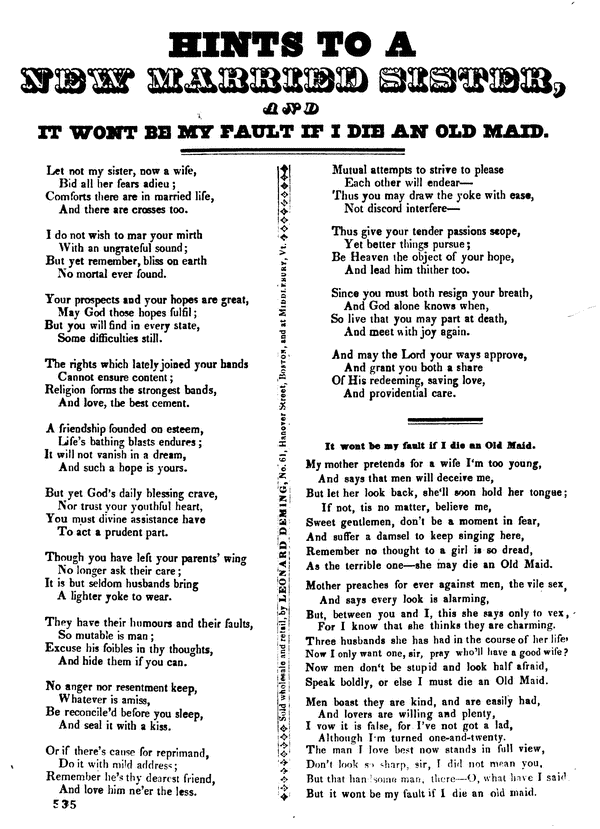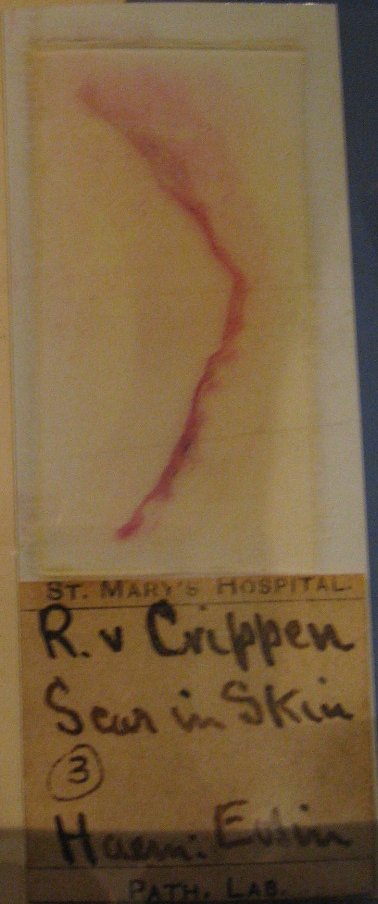|
Frederick Seddon
Frederick Henry Seddon (sometimes spelled Sedden) (21 January 1872 – 18 April 1912) was a British murderer hanging, hanged in 1912 for the arsenic poisoning murder of his lodger Eliza Mary Barrow. Background Frederick Seddon was born in Liverpool to William Seddon and Mary Ann (Married and maiden names, née Kennen) on 21 January 1872. He married Margaret Ann (''née'' Jones) (1878–1946) on 31 December 1893, and had five children with her: William James Seddon (b. 1894); Margaret Seddon (b. 1896); Frederick Henry Seddon Jr (b. 1897); Ada Seddon (b. 1905), and Lilian Louisa Agnes Emma Seddon (b. 1911). His father also lived with him. The names of William and Frederick Seddon appear in the visitors' book for the Metropolitan Police Black Museum, Crime Museum on 1 December 1905; the museum was not open to the general public and the reason for their visit is unknown. At one time Seddon had been a Freemasonry, Freemason, being initiated into Liverpool's Stanley Lodge No. 1325 in 1 ... [...More Info...] [...Related Items...] OR: [Wikipedia] [Google] [Baidu] |
Ancestry
An ancestor, also known as a forefather, fore-elder or a forebear, is a parent or (recursively) the parent of an antecedent (i.e., a grandparent, great-grandparent, great-great-grandparent and so forth). ''Ancestor'' is "any person from whom one is descended. In law, the person from whom an estate has been inherited." Two individuals have a genetic relationship if one is the ancestor of the other or if they share a common ancestor. In evolutionary theory, species which share an evolutionary ancestor are said to be of common descent. However, this concept of ancestry does not apply to some bacteria and other organisms capable of horizontal gene transfer. Some research suggests that the average person has twice as many female ancestors as male ancestors. This might have been due to the past prevalence of polygynous relations and female hypergamy. Assuming that all of an individual's ancestors are otherwise unrelated to each other, that individual has 2''n'' ancestors in the ... [...More Info...] [...Related Items...] OR: [Wikipedia] [Google] [Baidu] |
Spinster
''Spinster'' is a term referring to an unmarried woman who is older than what is perceived as the prime age range during which women usually marry. It can also indicate that a woman is considered unlikely to ever marry. The term originally denoted a woman whose occupation was to spin. A synonymous term is old maid. The closest equivalent term for males is "bachelor" or "confirmed bachelor", but this generally does not carry the same connotations in reference to age and perceived desirability in marriage. Etymology and history Long before the Industrial Age, "the art & calling of being a spinster" denoted girls and women who spun wool. According to the ''Online Etymological Dictionary'', spinning was "commonly done by unmarried women, hence the word came to denote" an unmarried woman in legal documents from the 1600s to the early 1900s, and "by 1719 was being used generically for 'woman still unmarried and beyond the usual age for it'". As a denotation for unmarried women ... [...More Info...] [...Related Items...] OR: [Wikipedia] [Google] [Baidu] |
Bernard Spilsbury
Sir Bernard Henry Spilsbury (16 May 1877 – 17 December 1947) was a British pathologist. His cases include Hawley Crippen, the Seddon case, the Major Armstrong poisoning, the "Brides in the Bath" murders by George Joseph Smith, the Crumbles murders, the Podmore case, the Sidney Harry Fox matricide, the Vera Page case, and the murder trials of Louis Voisin, Jean-Pierre Vaquier, Norman Thorne, Donald Merrett, Alfred Rouse, Elvira Barney, Toni Mancini, and Gordon Cummins. Spilsbury's courtroom appearances became legendary for his demeanour of effortless dominance. He also played a crucial role in the development of Operation Mincemeat, a deception operation during the Second World War which saved thousands of lives of Allied service personnel. Spilsbury died by suicide in 1947. Personal life Spilsbury was born on 16 May 1877 at 35 Bath Street, Leamington Spa, Warwickshire. He was the eldest of the four children of James Spilsbury, a manufacturing chemist, and his wife, Marion ... [...More Info...] [...Related Items...] OR: [Wikipedia] [Google] [Baidu] |
Pathology
Pathology is the study of the causes and effects of disease or injury. The word ''pathology'' also refers to the study of disease in general, incorporating a wide range of biology research fields and medical practices. However, when used in the context of modern medical treatment, the term is often used in a narrower fashion to refer to processes and tests that fall within the contemporary medical field of "general pathology", an area which includes a number of distinct but inter-related medical specialties that diagnose disease, mostly through analysis of tissue, cell, and body fluid samples. Idiomatically, "a pathology" may also refer to the predicted or actual progression of particular diseases (as in the statement "the many different forms of cancer have diverse pathologies", in which case a more proper choice of word would be " pathophysiologies"), and the affix ''pathy'' is sometimes used to indicate a state of disease in cases of both physical ailment (as in cardiomy ... [...More Info...] [...Related Items...] OR: [Wikipedia] [Google] [Baidu] |
William Willicox
William is a male given name of Germanic origin.Hanks, Hardcastle and Hodges, ''Oxford Dictionary of First Names'', Oxford University Press, 2nd edition, , p. 276. It became very popular in the English language after the Norman conquest of England in 1066,All Things William"Meaning & Origin of the Name"/ref> and remained so throughout the Middle Ages and into the modern era. It is sometimes abbreviated "Wm." Shortened familiar versions in English include Will, Wills, Willy, Willie, Bill, and Billy. A common Irish form is Liam. Scottish diminutives include Wull, Willie or Wullie (as in Oor Wullie or the play ''Douglas''). Female forms are Willa, Willemina, Wilma and Wilhelmina. Etymology William is related to the given name ''Wilhelm'' (cf. Proto-Germanic ᚹᛁᛚᛃᚨᚺᛖᛚᛗᚨᛉ, ''*Wiljahelmaz'' > German ''Wilhelm'' and Old Norse ᚢᛁᛚᛋᛅᚼᛅᛚᛘᛅᛋ, ''Vilhjálmr''). By regular sound changes, the native, inherited English form of the name shoul ... [...More Info...] [...Related Items...] OR: [Wikipedia] [Google] [Baidu] |
Geoffrey Crossick
Geoffrey Joel Crossick FRHistS (born 13 June 1946) is a British academic who is Professor of Humanities at the School of Advanced Study, a postgraduate school of the University of London. He was Vice-Chancellor of London University from 2010 to 2012. Early life The son of Louis Crossick and Rebecca Naomi ''née'' Backen, Crossick was educated at the Haberdashers' Aske's Boys' School Elstree, before going to Gonville and Caius College, Cambridge, where he read history, graduating as a BA in 1967. He then pursued further research historical at Birkbeck College, London, where he took a PhD in 1976. Career Elected a Research Fellow in History at Emmanuel College, Cambridge from 1970 to 1973, Crossick then became a Lecturer in Social History at the University of Hull from 1973 to 1978. In 1979 he joined the University of Essex becoming a Reader then Professor of History from 1991 to 2002 before becoming Pro-Vice-Chancellor from 1997 to 2002. Crossick was Chief Executive of the Arts ... [...More Info...] [...Related Items...] OR: [Wikipedia] [Google] [Baidu] |
Islington
Islington () is a district in the north of Greater London, England, and part of the London Borough of Islington. It is a mainly residential district of Inner London, extending from Islington's High Street to Highbury Fields, encompassing the area around the busy High Street, Upper Street, Essex Road (former "Lower Street"), and Southgate Road to the east. Modern definition Islington grew as a sprawling Middlesex village along the line of the Great North Road, and has provided the name of the modern borough. This gave rise to some confusion, as neighbouring districts may also be said to be in Islington. This district is bounded by Liverpool Road to the west and City Road and Southgate Road to the south-east. Its northernmost point is in the area of Canonbury. The main north–south high street, Upper Street splits at Highbury Corner to Holloway Road to the west and St. Paul's Road to the east. The Angel business improvement district (BID), an area centered around the Angel t ... [...More Info...] [...Related Items...] OR: [Wikipedia] [Google] [Baidu] |
Undertaker
A funeral director, also known as an undertaker (British English) or mortician (American English), is a professional involved in the business of funeral rites. These tasks often entail the embalming and burial or cremation of the dead, as well as the arrangements for the funeral ceremony (although not the directing and conducting of the funeral itself unless clergy are not present). Funeral directors may at times be asked to perform tasks such as dressing (in garments usually suitable for daily wear), casketing (placing the corpse in the coffin), and cossetting (applying any sort of cosmetic or substance to the best viewable areas of the corpse for the purpose of enhancing its appearance). A funeral director may work at a funeral home or be an independent employee. Etymology The term mortician is derived from the Roman word ''mort-'' (“death”) + ''-ician''. In 1895, the trade magazine ''The Embalmers' Monthly'' put out a call for a new name for the profession in the US ... [...More Info...] [...Related Items...] OR: [Wikipedia] [Google] [Baidu] |
Morphine
Morphine is a strong opiate that is found naturally in opium, a dark brown resin in poppies (''Papaver somniferum''). It is mainly used as a analgesic, pain medication, and is also commonly used recreational drug, recreationally, or to make other illicit drug, illicit opioids. There are numerous methods used to administer morphine: oral; sublingual administration, sublingual; via inhalation; intramuscular, injection into a muscle; by Subcutaneous injection, injection under the skin; intravenously; Intrathecally, injection into the space around the spinal cord; transdermal; or via rectal administration, rectal suppository. It acts directly on the central nervous system (CNS) to induce analgesia and alter perception and emotional response to pain. Physical and psychological dependence and tolerance may develop with repeated administration. It can be taken for both acute pain and chronic pain and is frequently used for pain from myocardial infarction, kidney stones, and during Ch ... [...More Info...] [...Related Items...] OR: [Wikipedia] [Google] [Baidu] |
Bismuth
Bismuth is a chemical element with the Symbol (chemistry), symbol Bi and atomic number 83. It is a post-transition metal and one of the pnictogens, with chemical properties resembling its lighter group 15 siblings arsenic and antimony. Elemental bismuth occurs naturally, and its sulfide and oxide forms are important commercial ores. The free element is 86% as dense as lead. It is a brittle metal with a silvery-white color when freshly produced. Passivation (chemistry), Surface oxidation generally gives samples of the metal a somewhat rosy cast. Further oxidation under heat can give bismuth a vividly Iridescence, iridescent appearance due to thin-film interference. Bismuth is both the most Diamagnetism, diamagnetic element and one of the least Thermal conductivity, thermally conductive metals known. Bismuth was long considered the element with the highest atomic mass whose nuclei do not spontaneously decay. However, in 2003 it was discovered to be extremely weakly radioactive. The ... [...More Info...] [...Related Items...] OR: [Wikipedia] [Google] [Baidu] |
Threepence (British Coin)
The British threepence piece, usually simply known as a threepence, ''thruppence'', or ''thruppenny bit'', was a denomination of sterling coinage worth of one pound or of one shilling. It was used in the United Kingdom, and earlier in Great Britain and England. Similar denominations were later used throughout the British Empire and Commonwealth countries, notably in Australia, New Zealand and South Africa. The sum of three pence was pronounced variously , or , reflecting different pronunciations in the various regions of the United Kingdom. The coin was often referred to in conversation as a , or bit. Before Decimal Day in 1971, sterling used the Carolingian monetary system, under which the largest unit was a pound divided into 20 shillings, each of 12 pence. The threepence coin was withdrawn in 1971 due to decimalisation and replaced by the decimal new penny, with 2.4''d'' being worth 1p. Early threepences The three pence coin – expressed in writing as " ... [...More Info...] [...Related Items...] OR: [Wikipedia] [Google] [Baidu] |



.jpg)
